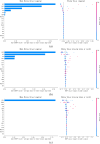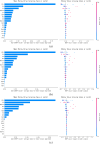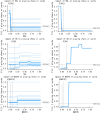Study on the mechanisms associating community outdoor public spaces with elderly behavior
- PMID: 40846883
- PMCID: PMC12373802
- DOI: 10.1038/s41598-025-16173-4
Study on the mechanisms associating community outdoor public spaces with elderly behavior
Abstract
As the global population ages, enhancing community outdoor public spaces to accommodate the needs of senior citizens has emerged as a critical challenge. This research delves into the intricate relationship between community outdoor public spaces and the behavioral patterns of the elderly, seeking to inform strategies for optimizing these spaces. The complexity and diversity of the mechanisms linking elderly behaviors with the characteristics of their outdoor environments pose challenges in identifying clear guidelines for improvement. Traditional methods of collecting behavioral data, such as questionnaires and manual observations, are time-consuming and limit the scope and detail of data captured. In contrast, computer vision technologies offer an efficient alternative for gathering behavioral data. However, the application of computer vision to specifically identify various behaviors of the elderly population presents certain challenges. This study addresses two key issues: improving the use of computer vision to recognize diverse behaviors of the elderly; and elucidating how community outdoor public spaces shape the outdoor activities of seniors and identifying crucial influencing factors. The research proceeds by initially categorizing elderly behavior characteristics and typologies of outdoor public spaces based on the physiological and psychological needs of seniors. The spatial elements are classified into four metrics: spatial, greenness, functional facilities, and accessibility. A computer vision-based behavior detection algorithm is then constructed to effectively identify six typical activities of the elderly: exercising, jogging, sitting, standing, walking, and playing chess or cards. Subsequently, a set of quantifiable indicators for community outdoor public spaces is established, and nonlinear machine learning models (Random Forest, Gradient Boosting Decision Tree, and eXtreme Gradient Boosting) are employed to reveal the association mechanisms between these six behaviors and the four categories of spatial metrics. The findings highlight 16 major characteristics that have a significant impact on elderly behavior, such as area size, form, green enclosure, and types of workout equipment.
Keywords: Association mechanisms; Community outdoor public spaces; Elderly behavior.
© 2025. The Author(s).
Conflict of interest statement
Declarations. Competing interests: The authors declare no competing interests. Ethics and consent: All methods in this study were carried out in accordance with relevant guidelines and regulations. All experimental protocols were approved by the Institutional Review Chess of North China University of Technology (NCUT). Informed consent was obtained from all subjects participating in the study. This study strictly adhered to ethical principles in the collection and processing of video data involving older people, ensuring the protection of participants’ privacy and rights. The specific ethical measures are as follows: (1) Anonymization: Data collection occurred in public spaces without identifying or tracking specific individuals (e.g., faces or names), complying with ethical exemptions for non-invasive observation in public settings. To further safeguard privacy, all videos underwent anonymization processing to ensure individuals could not be traced. (2) Restricted Research Purpose: The study collected only the behavioral data necessary for research, used exclusively for extracting behavioral data through computer vision behavior detection algorithms, and not for any other purposes. (3) Ethical Review: The research protocol was approved by the Ethics Committee of North China University of Technology. (4) Data Security: Video data were accessible only to the research team, with external sharing of video clips strictly prohibited. In accordance with ethics committee requirements, all data will be destroyed within six months after the study’s completion, in compliance with data protection regulations.
Figures





























Similar articles
-
Prescription of Controlled Substances: Benefits and Risks.2025 Jul 6. In: StatPearls [Internet]. Treasure Island (FL): StatPearls Publishing; 2025 Jan–. 2025 Jul 6. In: StatPearls [Internet]. Treasure Island (FL): StatPearls Publishing; 2025 Jan–. PMID: 30726003 Free Books & Documents.
-
Sexual Harassment and Prevention Training.2024 Mar 29. In: StatPearls [Internet]. Treasure Island (FL): StatPearls Publishing; 2025 Jan–. 2024 Mar 29. In: StatPearls [Internet]. Treasure Island (FL): StatPearls Publishing; 2025 Jan–. PMID: 36508513 Free Books & Documents.
-
Short-Term Memory Impairment.2024 Jun 8. In: StatPearls [Internet]. Treasure Island (FL): StatPearls Publishing; 2025 Jan–. 2024 Jun 8. In: StatPearls [Internet]. Treasure Island (FL): StatPearls Publishing; 2025 Jan–. PMID: 31424720 Free Books & Documents.
-
Health professionals' experience of teamwork education in acute hospital settings: a systematic review of qualitative literature.JBI Database System Rev Implement Rep. 2016 Apr;14(4):96-137. doi: 10.11124/JBISRIR-2016-1843. JBI Database System Rev Implement Rep. 2016. PMID: 27532314
-
Management of urinary stones by experts in stone disease (ESD 2025).Arch Ital Urol Androl. 2025 Jun 30;97(2):14085. doi: 10.4081/aiua.2025.14085. Epub 2025 Jun 30. Arch Ital Urol Androl. 2025. PMID: 40583613 Review.
References
-
- Han, W.-J. & Shibusawa, T. Trajectory of physical health, cognitive status, and psychological well-being among Chinese elderly. Arch. Gerontol. Geriatr.60, 168–177. 10.1016/j.archger.2014.09.001 (2015). - PubMed
-
- Jian, M., Su, D., Du, Y., Cao, J. & Li, C. Exploring the influence of walking on quality of life among older adults: Case study in Hohhot. China J. Transp. Health32, 101684. 10.1016/j.jth.2023.101684 (2023).
-
- Marcos-Pardo, P. J., Espeso-García, A., Abelleira-Lamela, T. & Machado, D. R. L. Optimizing outdoor fitness equipment training for older adults: Benefits and future directions for healthy aging. Exp. Gerontol.181, 112279. 10.1016/j.exger.2023.112279 (2023). - PubMed
-
- Ma, J., Zhao, S. & Li, W. Threshold effect of unmet walking needs on quality of life for seniors. Transp. Res. D Transp. Environ.124, 103894. 10.1016/j.trd.2023.103894 (2023).
-
- Ni, H.-J. et al. Effects of Exercise Programs in older adults with Muscle Wasting: A Systematic Review and Meta-analysis. Arch. Gerontol. Geriatr.99, 104605. 10.1016/j.archger.2021.104605 (2022). - PubMed
MeSH terms
Grants and funding
LinkOut - more resources
Full Text Sources
Research Materials

